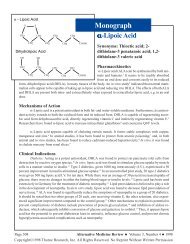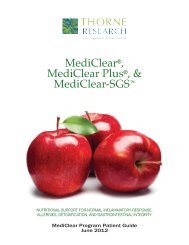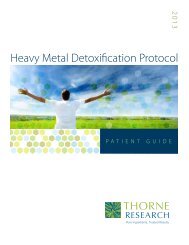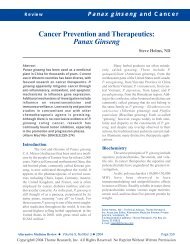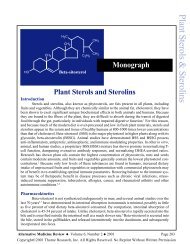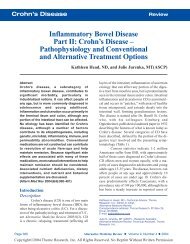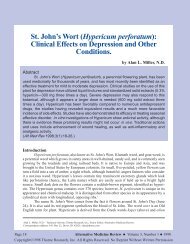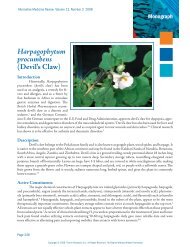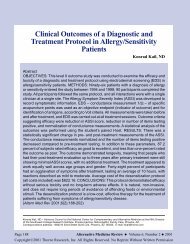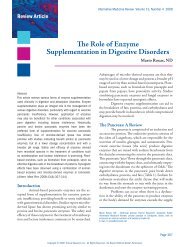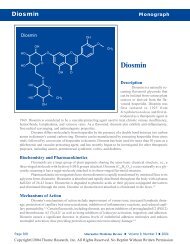Therapeutic Applications Of Whey Protein - Thorne Research
Therapeutic Applications Of Whey Protein - Thorne Research
Therapeutic Applications Of Whey Protein - Thorne Research
Create successful ePaper yourself
Turn your PDF publications into a flip-book with our unique Google optimized e-Paper software.
<strong>Whey</strong> <strong>Protein</strong>Review<strong>Therapeutic</strong> <strong>Applications</strong>of <strong>Whey</strong> <strong>Protein</strong>Keri Marshall, ND, MSAbstract<strong>Whey</strong>, a protein complex derived from milk, isbeing touted as a functional food with a numberof health benefits. The biological componentsof whey, including lactoferrin, betalactoglobulin,alpha-lactalbumin,glycomacropeptide, and immunoglobulins,demonstrate a range of immune-enhancingproperties. In addition, whey has the ability toact as an antioxidant, antihypertensive,antitumor, hypolipidemic, antiviral,antibacterial, and chelating agent. The primarymechanism by which whey is thought to exertits effects is by intracellular conversion of theamino acid cysteine to glutathione, a potentintracellular antioxidant. A number of clinicaltrials have successfully been performed usingwhey in the treatment of cancer, HIV, hepatitisB, cardiovascular disease, osteoporosis, andas an antimicrobial agent. <strong>Whey</strong> protein hasalso exhibited benefit in the arena of exerciseperformance and enhancement.(Altern Med Rev 2004;9(2):136-156)IntroductionIn recent years, milk constituents havebecome recognized as functional foods, suggestingtheir use has a direct and measurable effect onhealth outcomes. 1 <strong>Whey</strong>, a by-product of cheeseand curd manufacturing, was once considered awaste product. The discovery of whey as a functionalfood with nutritional applications elevatedwhey to a co-product in the manufacturing ofcheese. 2 Milk contains two primary sources ofprotein, the caseins and whey. After processingoccurs, the caseins are the proteins responsible formaking curds, while whey remains in an aqueousenvironment. The components of whey includebeta-lactoglobulin, alpha-lactalbumin, bovine serumalbumin, lactoferrin, immunoglobulins, lactoperoxidaseenzymes, glycomacropeptides, lactose,and minerals. 2 In additional, whey derivedfrom buttermilk versus cheese contains the lipidsphingomyelin.Several cultures consider fermented foodspart of a healthful diet. Historically, whey wasconsidered a cure-all used to heal ailments rangingfrom gastrointestinal complaints to joint andligament problems. Nanna Rognvaldardottir, anIcelandic food expert, describes how whey, calledsyra by the Icelandic people, is fermented andstored in barrels. Syra is diluted with water andingested or used as a marinade or preservative formeat and other food. Syra was the most commonbeverage of Icelandic people and is thought to havereplaced ale, due to lack of grains in the region. 3Today, whey is a popular dietary proteinsupplement purported to provide antimicrobialactivity, immune modulation, improved musclestrength and body composition, and to preventcardiovascular disease and osteoporosis. Advancesin processing technology, including ultrafiltration,microfiltration, reverse osmosis, and ion-exchange,have resulted in development of severaldifferent finished whey products. <strong>Whey</strong> proteinconcentrates (ranging from 80-95 percent protein),reduced lactose whey, whey protein isolate, demineralizedwhey, and hydrolyzed whey are nowKeri Marshall, MS, ND – 1996 Master of Science Socialand Preventive Medicine, State University of New York atBuffalo; 2001 graduate, National College of NaturopathicMedicine. Private practice, Sandpoint, Idaho.Correspondence address: 515 Pine Street, Suite H,Sandpoint, ID 83864Email: mackaynd@aol.comPage 136 Alternative Medicine Review ◆ Volume 9, Number 2 ◆ 2004Copyright©2004 <strong>Thorne</strong> <strong>Research</strong>, Inc. All Rights Reserved. No Reprint Without Written Permission
Review<strong>Whey</strong> <strong>Protein</strong>Table 1. Types of Commercially Available <strong>Whey</strong> <strong>Protein</strong>sProduct Description<strong>Whey</strong> <strong>Protein</strong> Isolate<strong>Whey</strong> <strong>Protein</strong> ConcentrateHydrolyzed <strong>Whey</strong> <strong>Protein</strong><strong>Protein</strong> Concentration90-95%Ranges from 25-89%Most commonly available as 80%VariableHydrolysis used to cleave peptide bondsLarger proteins become smaller peptide fractionsReduces allergic potential comparedwith non-hydrolyzedFat, Lactose, and Mineral ContentLittle if anySome fat, lactose, and mineralsAs protein concentration increases, fat,lactose, and mineral content decreases.Varies with protein concentrationUndenatured <strong>Whey</strong> ConcentrateVariableUsually ranges from 25-89%Some fat, lactose, and mineralsAs protein concentration increases, fat,lactose, and mineral content decreases.Processed to preserve native proteinstructures; typically have higher amountsof immunoglobulins and lactoferrinavailable commercially. Each whey product variesin the amount of protein, carbohydrates, immunoglobulins,lactose, minerals, and fat in thefinished product. These variables are importantfactors in the selection of whey fractions for specificnutritional applications. Table 1 describes thevarious whey protein products available.<strong>Whey</strong> <strong>Protein</strong> Manufacturing<strong>Protein</strong> from bovine whole milk consistsof approximately 20-percent whey protein. Whencasein is removed from whole milk, liquid wheyremains, having a protein concentration of about65 percent. The following is a summary of theOhio State University method of manufacturingwhey protein powder. Milk is high-temperature,short-time pasteurized (163 degrees F for 30 seconds)and held overnight at 40 degrees C. Thefollowing morning the mixture is cooled to 30degrees C, inoculated with a lactic acid culture,and incubated for 30 minutes. Rennet extract isadded and the mixture is stirred, resulting in coagulationof curd.Rennet is derived from the abomasum(fourth stomach) of newly born calves. Chymosin,the active enzyme ingredient of rennet, aids in thecoagulation of milk by separating it into curds andwhey. In a newly born calf, chymosin aides in thedigestion and absorption of milk. Adult cows donot have this enzyme.The liquid whey is drained through a stainlesssteel screen and the remaining curd is cut andcooked at 30 degrees C. <strong>Whey</strong> liquid is then filteredat 45 degrees C and brought to a pH of 3 byadding citric acid. The liquid is filtered to onefifthits original volume, resulting in whey concentratethat is approximately 80-percent protein.This can be additionally micro-filtered to increaseprotein concentration to as high as 95 percent.Alternative Medicine Review ◆ Volume 9, Number 2 ◆ 2004 Page 137Copyright©2004 <strong>Thorne</strong> <strong>Research</strong>, Inc. All Rights Reserved. No Reprint Without Written Permission
<strong>Whey</strong> <strong>Protein</strong>ReviewTable 2. Amino Acid Residues in Bovine versus HumanLactoferrinAlanineProlineArginineLysineAsparagineValineTryptophanCysteineThreonineIsoleucineSerineGlutamineGlutamic acidPhenylalanineMethionineLeucineGlycineTyrosineAspartic AcidHistidineTotal number of residuesBovine Lactoferrin Human Lactoferrin67303954294713343615452940274654822369689The final whey protein concentrate iswarmed and spray-dried to achieve whey proteinpowder. <strong>Whey</strong> protein concentrates can then beput through an ion-exchange process to remove63354346334810323116502742305585421389691From: Pierce A, Colavizza D, Benaissa M, et al. Molecular cloning andsequence analysis of bovine lactoferrin. Eur J Biochem 1991;196:177-184.fat and lactose. In addition,some manufacturers hydrolyze(cleaving peptide bondsvia enzymes or heat) the wheyto provide more peptides andfree amino acids in the finalproduct. 4 The commercial successof whey protein has ledto the development of highquality whey protein supplementsmanufactured as primaryproducts and not as a byproductof cheese manufacturing.Manufacturers take specialcare to preserve the biologicalactivity, native proteinstructure, and protein-boundfatsin the finished product.<strong>Protein</strong>s are processed underlow temperatures and not exposedto fluctuating pHchanges to avoid denaturingthe native structures. In addition,the source of milk and thehealth of the milking cows isthought to contribute to immune-enhancingactivity ofwhey products. 5,6BiologicalComponentsAmino Acid ContentCollectively, wheyproteins have all the essentialamino acids and in higher concentrationscompared to variousvegetable protein sourcessuch as soy, corn, and wheatgluten. 2 In addition to havinga full spectrum of amino acids,the amino acids found in whey are efficientlyabsorbed and utilized, relative to free amino acidsolutions. 7Page 138 Alternative Medicine Review ◆ Volume 9, Number 2 ◆ 2004Copyright©2004 <strong>Thorne</strong> <strong>Research</strong>, Inc. All Rights Reserved. No Reprint Without Written Permission
Review<strong>Whey</strong> <strong>Protein</strong>Relative to other protein sources, wheyhas a high concentration of branched-chain aminoacids (BCAAs) – leucine, isoleucine, and valine.BCAAs, particularly leucine, are important factorsin tissue growth and repair. Leucine has beenidentified as a key amino acid in protein metabolismduring the translation-initiation pathway ofprotein synthesis. 8<strong>Whey</strong> proteins are also rich in the sulfurcontainingamino acids cysteine and methionine.With a high concentration of these amino acids,immune function is enhanced through intracellularconversion to glutathione.LactoferrinLactoferrin, an iron-binding glycoprotein,is a non-enzymatic antioxidant found in the wheyfraction of milk as well as in colostrums. Thelactoferrin component of whey consists of approximately689 amino acid residues, while humanlactoferrin consists of 691 residues. 9 <strong>Whey</strong>lactoferrin is composed of a single polypeptidechain with two binding sites for ferric ions. Beforeprocessing, bovine lactoferrin is only 15-20percent saturated with iron. Iron-depletedlactoferrin, defined as containing less than fivepercentiron, is referred to as apolactoferrin. Humanbreast milk contains apolactoferrin. 10 Theconcentration of lactoferrin in human milk andcolostrums is approximately 2 mg/mL and 7 mg/mL, respectively, while in bovine milk and colostrumsit is approximately 0.2 mg/mL and 1.5 mg/mL, respectively. 11 Lactoferrin is a dominant componentof whey protein in human breast milk;however, the concentration in most commercialwhey protein powders is only 0.35-2.0 percent oftotal proteins. Table 2 illustrates the difference inamino acid profiles between bovine and humanlactoferrin.ImmunoglobulinsAn immunoglobulin (Ig) is an antibodyor gamma-globulin. There are five classes ofantibodies – IgA, IgD, IgE, IgG, and IgM. IgGconstitutes approximately 75 percent of theantibodies in an adult. IgG is transferred frommother to child in utero via cord blood and bybreast-feeding, and serves as a child’s first line ofimmune defense – referred to as “passiveimmunity.” IgA is secreted in breast milk andultimately transferred to the digestive tract in thenewborn infant, providing better immunity than abottle-fed child. 12 Colostrums contain significantlygreater concentrations of immunoglobulins thanmature milk. Immunoglobulins reach maximumconcentration the first 24-48 hours post-parturitionand decline in a time-dependent manner followingpeak concentration. 13Similarly, the whey fraction of milk appearsto contain a significant amount of immunoglobulins,approximately 10-15 percent of totalwhey proteins. An in vitro study demonstrated bovinemilk-derived IgG suppresses human lymphocyteproliferative response to T cells at levels aslow as 0.3 mg/mL of IgG. The authors further concludebovine milk IgG typically ranges between0.6-0.9 mg/mL and is therefore likely to conferimmunity that could be carried to humans. 14 Studiesshow raw milk from non-immunized cows containspecific antibodies to human rotavirus, as wellas antibodies to bacteria such as E. coli, Salmonellaenteriditis, S. typhimurium, and Shigellaflexneri. 15,16beta-Lactoglobulinbeta-Lactoglobulin represents approximatelyhalf of the total protein in bovine whey,while human milk contains no beta-lactoglobulin.Besides being a source of essential andbranched chain amino acids, a retinol-binding proteinhas been identified within the beta-lactoglobulinstructure. This protein, a carrier of smallhydrophobic molecules including retinoic acid, hasthe potential to modulate lymphatic responses. 17alpha-Lactalbuminalpha-Lactalbumin is one of the mainproteins found in human and bovine milk. Itcomprises approximately 20-25 percent of wheyproteins and contains a wide variety of aminoacids, including a readily available supply ofessential and branched chain amino acids. Purifiedalpha-lactalbumin is most readily used in infantAlternative Medicine Review ◆ Volume 9, Number 2 ◆ 2004 Page 139Copyright©2004 <strong>Thorne</strong> <strong>Research</strong>, Inc. All Rights Reserved. No Reprint Without Written Permission
<strong>Whey</strong> <strong>Protein</strong>ReviewTable 3. Components Found in <strong>Whey</strong> <strong>Protein</strong><strong>Whey</strong> Componentsbeta-Lactoglobulinalpha-LactalbuminImmunoglobulinsLactoferrinLactoperoxidaseBovine Serum AlbuminGlycomacropeptide% of <strong>Whey</strong> <strong>Protein</strong>50-55%20-25%10-15%1-2%0.50%5-10%10-15%BenefitsSource of essential and branched chainamino acidsPrimary protein found in human breast milkSource of essential and branched chainamino acidsPrimary protein found in colostrumImmune modulating benefitsAntioxidantAntibacterial, antiviral , and antifungalPromotes growth of beneficial bacteriaNaturally occurs in breast milk, tears,saliva, bile, blood, and mucusInhibits growth of bacteriaSource of essential amino acidsLarge proteinSource of branched chain amino acidsLacks the aromatic amino acidsphenylalanine, tryptophan, and tyrosineformula manufacturing, as it has the moststructurally similar protein profile compared tobreast milk. However, due to cost effectivemeasures, most dairy-based infant formulascontain ingredients such as demineralized wheywith higher levels of beta-lactoglobulin, makingthem less similar to human milk.In a murine study, alpha-lactalbumin, inboth the native and hydrolyzed state, enhancedantibody response to systematic antigen stimulation.18 The same group proved alpha-lactalbuminhas a direct effect on B-lymphocyte function, aswell as suppressing T cell-dependent and -independentresponses. 19Lactoperoxidase<strong>Whey</strong> contains many types of enzymes,including hydrolases, transferases, lyases, proteases,and lipases. Lactoperoxidase, an importantenzyme in the whey fraction of milk, is the mostabundant enzyme and the majority of it ends up inwhey following the curding process. Lactoperoxidaseaccounts for 0.25-0.5 percent of total proteinfound in whey. It has the ability to catalyze certainmolecules, including the reduction of hydrogenperoxide. 20 This enzyme system catalyzesperoxidation of thiocyanate and some halides(such as iodine and bromium), which ultimatelygenerates products that inhibit and/or kill a rangeof bacterial species. 21 During the pasteurizationprocess, lactoperoxidase is not inactivated, suggestingits stability as a preservative.Page 140 Alternative Medicine Review ◆ Volume 9, Number 2 ◆ 2004Copyright©2004 <strong>Thorne</strong> <strong>Research</strong>, Inc. All Rights Reserved. No Reprint Without Written Permission
Review<strong>Whey</strong> <strong>Protein</strong>GlycomacropeptideGlycomacropeptide (GMP) is also referredto as casein macropeptide. GMP is a proteinpresent in whey at 10-15 percent, due to theaction of chymosin on casein during the cheesemakingprocess. GMP is only present whenchymosin is used during processing; therefore,cheeses such as cottage cheese not made withchymosin do not produce GMP in the curding process.22 GMP is high in branched chain amino acidsand lacks the aromatic amino acids includingphenylalanine, tryptophan, and tyrosine. It is oneof the few naturally occurring proteins that lacksphenylalanine, making it safe for individuals withphenylketonuria (PKU).form. Riboflavin, niacinamide, and glutathione reductaseare essential cofactors in the reduction ofglutathione. 23 As a result of the glutathione/antioxidantcomponent of whey, it is being investigatedas an anti-aging agent. 24As a detoxifying agent, glutathione peroxidase(GSHPx), which is derived from seleniumand cysteine, is an endogenous antioxidant enzymewith the ability to convert lipid peroxides into lessharmful hydroxy acids. The peroxidases interactwith hydrogen peroxide to reduce it to water, negatingits oxidative potential. Both glutathioneperoxidase activity and selenium concentrationshave been shown to decrease as lactation continues,peaking at approximately one month afterBovine SerumAlbuminBovine serumalbumin (BSA) is alarge protein that makesup approximately 10-15percent of total wheyprotein. BSA is a sourceof essential aminoacids, but there is verylittle available informationregarding its potentialtherapeutic activity.Table 3 summarizesthe componentsfound in whey.Mechanism ofAction<strong>Whey</strong> has potentantioxidant activity,likely by contributingcysteine-rich proteinsthat aid in the synthesis of glutathione (GSH),a potent intracellular antioxidant. 2 GSH is comprisedof glycine, glutamate, and cysteine (Figure1). Cysteine contains a thiol (sulfhydryl) groupthat serves as an active reducing agent in preventingoxidation and tissue damage. As an antioxidant,glutathione is most effective in its reducedFigure 1. Synthesis of Glutathione from Cysteine, Glutamate,and GlycineStep 1 Glutamic acid+Cysteine+ATPStep 2g-Glutamylcysteinesynthetaseg-Glutamylcysteine+ADP+Pg-Glutamylcysteine+Glycine+ATPGlutathionesynthetaseGlutathione+ADP+Pinitiation. Practitioners use whey protein productsas a source of cysteine to increase intracellularglutathione levels 25,26 and it has been reported thatGSHPx activity in cow’s milk, and presumablywhey, is the same as in human milk. 27Alternative Medicine Review ◆ Volume 9, Number 2 ◆ 2004 Page 141Copyright©2004 <strong>Thorne</strong> <strong>Research</strong>, Inc. All Rights Reserved. No Reprint Without Written Permission
<strong>Whey</strong> <strong>Protein</strong>ReviewStudies on lactoferrin have demonstratedits ability to activate natural killer (NK) cells andneutrophils, induce colony-stimulating factor activity,and enhance macrophage cytotoxicity. 28-31Lactoferrin also appears to have antiviral,antifungal, and antibacterial properties. Theantimicrobial effect is likely more potent in organismsthat require iron to replicate, as lactoferrinhas the unique ability to chelate iron in a way thatdeprives microorganisms of this essential nutrientfor growth. 32 In additional, lactoferrin has theability to release the outer membrane of gramnegativebacteria, the lipopolysaccharide component,thus acting as an antibiotic. 33Lactoferrin demonstrates anti-inflammatoryproperties. A mouse study revealed lactoferrinhad the ability to regulate levels of tumor necrosisfactor (TNF) and interleukin 6 (IL-6), thusdecreasing inflammation and, ultimately, mortality.34In addition to the above-mentioned properties,alpha-lactalbumin can chelate heavy metals.35 It reduces oxidative stress because of its ironchelatingproperties. 36<strong>Whey</strong> has been recently touted as a healthfuldietary supplement to reduce blood pressure.Antihypertensive peptides have been isolated inthe primary sequence of bovine beta-lactoglobulin.37 These peptides give whey significant angiotensinI converting enzyme (ACE) inhibitory activity,which blocks the conversion of angiotensinI to angiotensin II, a highly potent vasoconstrictormolecule. 38 beta-Lactoglobulin has been describedby Nagaoka et al as a cholesterol-loweringagent. In animal studies, beta-lactoglobulininhibited cholesterol absorption by changing micellarcholesterol solubility in the intestine. 39Absorption and Digestion of Milk<strong>Protein</strong>s: Casein versus <strong>Whey</strong> andLactoferrinThe physical manifestations of milk in thegut vary, based on the type of milk protein. <strong>Whey</strong>comprises approximately 20 percent of milk protein,while 80 percent of protein in milk is casein. 32These two proteins possess quite different properties.Casein proteins form curds in the stomach,increasing hydrolysis and slowing entrance to thesmall intestine. <strong>Whey</strong> proteins, on the other hand,do not coagulate under acidic conditions. They areconsidered to be “fast proteins,” as they reach thejejunum quickly after entering the gastrointestinaltract. 40 After reaching the small intestine, thehydrolysis of whey is slower than that of casein,allowing for greater absorption over the length ofthe small intestine.A study by Arnal et al demonstrates thatwhey’s rapid absorption patterns are superior forpostprandial protein utilization and overall nitrogenbalance in elderly women. 41 Most recently, arandomized, single-blind study examining proteinsatiety found whey protein to exhibit a higher postprandiallevel of plasma amino acids compared tocasein. 42 A study by Troost et al examined the effectsof an orally administered recombinant humanlactoferrin (rhLF) in the digestive tract. Thestudy population consisted of eight female ileostomypatients who consumed 5 g rhLF and collectedfull ileostomy output for 24 hours. In a 24-hour period, only 4 µg of lactoferrin were excreted.The study concluded dietary rhLF does not reachthe colon because it is digested in the stomach andsmall intestine. 43 A similar study by the same groupwas conducted on 12 healthy volunteers. On threeseparate days, volunteers were instructed to consume4.5 g lactoferrin. After conclusion of thestudy, results revealed bovine lactoferrin survivedpassage through the stomach, demonstrating theability of this protein to survive in an acidic environment.44Clinical Indications for <strong>Whey</strong>Cancer<strong>Whey</strong> protein concentrates have been researchedextensively in the prevention and treatmentof cancer. Glutathione stimulation is thoughtto be the primary immune-modulating mechanism.In a review of whey protein concentrates in thetreatment of cancer, Bounous discusses the antitumorand anticarcinogenic potential. The aminoacid precursors to glutathione available in wheymight: (1) increase glutathione concentration inrelevant tissues, (2) stimulate immunity, and (3)Page 142 Alternative Medicine Review ◆ Volume 9, Number 2 ◆ 2004Copyright©2004 <strong>Thorne</strong> <strong>Research</strong>, Inc. All Rights Reserved. No Reprint Without Written Permission
Review<strong>Whey</strong> <strong>Protein</strong>detoxify potential carcinogens. 45 Other authorsconclude the iron-binding capacity of whey mayalso contribute to anticancer potential, as iron mayact as a mutagenic agent causing oxidative damageto tissues. 46Many animal studies have examined theeffects of whey and its immune-enhancing components,including lactoferrin and beta-lactoglobulin.47-54 In animal studies where colon cancer wasinduced, whey demonstrated significantly lowerincidence of tumors, as well as fewer aberrantcrypts. 47,49,52,54 When whey-based protein powderswere compared to soy-based protein powders,similar effects were also observed. 48,52 Yoo et aldemonstrated lactoferrin has the ability to inhibitmetastasis of primary tumors in mice with cancer.50 Bovine serum albumin (10-15 percent of totalwhey protein) has demonstrated inhibition ofgrowth in human breast cancer cells in vitro. 55 Ahamster study demonstrated fractionated whey hasthe ability to prevent and treat 5-fluorouracil chemotherapy-inducedoral mucositis. 56 This protectionis thought to occur via induction of tumorgrowth factor-beta (TGF-β), which reduces basalepithelial cell proliferation.A recent in vitro study by Kent et al demonstratedthat an isolate of whey protein, whencompared to a casein-based protein, increased glutathionesynthesis and protected human prostatecells against oxidant-induced cell death. 57 An invitro study on a human hepatoma cell line wasconducted using a high lactoferrin whey concentrate(Immunocal ® ), a baicalein medium, or a combinationof the two. 58 Baicalein, a potential anticancerdrug, is a flavonoid extracted fromScutellaria revularis that is thought to have antitumoractivity. Immunocal alone did not have asignificant impact on the hepatoma cell line. However,when Immunocal was combined withbaicelein, cytotoxicity was enhanced by inducinga higher rate of apoptosis than in the group treatedwith baicalein alone.To date, few clinical trials on whey andcancer have been conducted. It has been proposedthat GSH concentrations are high in tumor cells,giving them resistance to chemotherapeuticagents. 59 In 1995, a small trial was conducted onfive patients with metastatic carcinoma of thebreast, one patient with pancreatic cancer, and onewith liver cancer. 59 Patients were given 30 g wheyprotein concentrate (Immunocal) for six months.In six patients, blood lymphocyte GSH was elevatedinitially, suggesting high tumor GSH levels.After completion of the study, two of the patientsshowed signs of tumor regression and a returnof lymphocyte GSH levels to normal, whiletwo patients showed signs of tumor stabilizationwithout normalization of glutathione levels. Threepatients had progression of disease and lymphocyteGSH levels increased from initial measurements.The conflicting results and small size ofthis study indicate the need for a larger clinicaltrial to investigate the potential of a whey proteinconcentrate singly and as an adjunct to chemotherapy.In a recent clinical trial, 20 patients withstage IV malignancies (one bladder, five breast,two prostate, one neuroblastoma, one ovarian, onegastric, three colon, one mesothelioma, two lymphoma,two non-small cell lung, and one osteosarcoma)received a combination of 40 g/day nondenaturedwhey protein concentrate, 50-100 g/dayintravenous Transfer Factor Plus ® (a supplementcontaining several immunoactive components), 1-2 g/day oral ascorbic acid, Agaricus blazei tea, amultiple vitamin/mineral complex, 500 mgAndrographis paniculata twice daily, and a soyextract for six months. 60 After six months therewere 16 survivors, all of whom had significantlyhigher NK function and higher mean hemoglobinand hematocrit levels. All patients noted havingan improved quality of life during the course ofthe study. No comparison was made between thiscombination therapy and whey protein alone.Hepatitis<strong>Whey</strong> protein supplementation demonstratesvariable effects in patients infected withHepatitis B or C. Initially it was found that bovinelactoferrin prevented hepatitis C virus (HCV)infection in vitro in a human hepatocyte line. 61These results prompted further clinical trials.A pilot study was conducted on 11 patientswith chronic HCV. Each patient received either1.8 or 3.6 g bovine lactoferrin daily for eightAlternative Medicine Review ◆ Volume 9, Number 2 ◆ 2004 Page 143Copyright©2004 <strong>Thorne</strong> <strong>Research</strong>, Inc. All Rights Reserved. No Reprint Without Written Permission
<strong>Whey</strong> <strong>Protein</strong>ReviewTable 4. Comparison of <strong>Whey</strong> Products Immunocaland ProtectaminAmino AcidAsparticGlutamicSerineGlycineHistidineArginineThreonineAlanineProlineTyrosineValineMethionineIsoleucineLeucinePhenylalanineLysineTryptophanCysteine/CystineMineralsSodiumPotassiumCalciumChloridePhosphateMagnesiumImmunocal (g/100 g)9.8016.373.561.642.042.304.634.803.763.764.532.136.4112.564.0010.682.864.170.30.50.40.40.30.3Protectamin (g/100 g)10.5017.485.581.841.732.246.974.876.011.976.062.276.329.963.159.191.532.280.10.50.30.10.30.1From: Micke P, Beeh KM, Buhl R. Effects of long-term supplementation withwhey proteins on plasma glutathione levels of HIV-infected patients. Eur J Nutr2002;41:12-18.weeks. In patients with low pretreatmentviral loads of HCV, decreasesin HCV RNA and serumalanine transaminase were observed.In patients with higherpretreatment HCV viral loads,levels did not change significantly.62 A dose-response trial of45 individuals with HCV wasconducted at doses of 1.8, 3.6,and 7.2 g lactoferrin daily foreight weeks. 63 A virological responsewas observed in only fourpatients, although HCV RNAwas still detectable. Eight patientshad a virological response– a 50 percent or greater decreasein HCV RNA – eight weeks afterthe treatment ended. Therewere no significant variations indose-dependant responses. Thistrial left many unanswered questionsfor future studies regardingwhey supplementation and HCV,including optimum dose, duration,and the potential effects ofcombining supplementation withconventional treatments such asinterferon therapy.In an open study on 25patients diagnosed with eitherHepatitis B or C, patients weregiven 12 g whey (Immunocal)twice daily for 12 weeks. 64 Priorto the start of treatment withwhey, patients were given 12 gcasein protein daily for twoweeks. Patients were also givencasein following Immunocal fora four-week period. In the 17 patientswith HCV, no significantchanges were noted. In the groupwith hepatitis B virus (HBV),serum lipid peroxidase levelsdecreased, while IL-2 and NKactivity increased. In six of eightHBV patients serum alaninePage 144 Alternative Medicine Review ◆ Volume 9, Number 2 ◆ 2004Copyright©2004 <strong>Thorne</strong> <strong>Research</strong>, Inc. All Rights Reserved. No Reprint Without Written Permission
Review<strong>Whey</strong> <strong>Protein</strong>transferase levels were reduced, while plasma glutathionelevels increased in five of the same eight.This trial shows promise for the use of whey proteinin the treatment of HBV.Human Immunodeficiency Virus(HIV)Glutathione deficiency is a common problemfor individuals infected with HIV. In an effortto increase cysteine, and ultimately glutathione,several studies have been conducted on the use ofwhey proteins in HIV-positive individuals. 65,66 Ina study by Micke et al, 30 subjects with HIV wererandomized to receive a daily dose of 45 g wheyprotein from one of two sources – Protectamin ®or Immunocal. The two products have differentamino acid profiles and Immunocal is producedat a lower isolation temperature (
<strong>Whey</strong> <strong>Protein</strong>Reviewagainst Pseudomonas aeruginosa, Listeriamonocytogenes, and E. coli. 32,80 In addition to theabove-mentioned bacteria, lactoferrin has alsodemonstrated antifungal activity toward Candidaalbicans. 81Cardiovascular DiseaseIn recent years, studies have linked a highfatdiet to an increased risk of cardiovascular disease(CVD). Because CVD is linked to a numberof other factors, including increased age, genetics,obesity, sedentary lifestyle, and alcohol intake,quality of dietary fat must be taken into consideration.Milk is composed of more than 12 differenttypes of fat, including sphingolipids, free sterols,cholesterol, and oleic acid. 82 Several studies havefound milk intake and milk products lower bloodpressure and reduce the risk of hypertension. 83-85A study was conducted on a group of 20healthy adult males to investigate whether a fermentedmilk supplement with an added whey proteinconcentrate would affect serum lipids andblood pressure. 86 The fermented milk containedboth Lactobacillus casei and Streptococcusthermophilus. During the course of eight weeks,volunteers consumed 200 mL of fermented milkwith whey protein concentrate or a placebo in themorning and evening. The placebo consisted of anon-fermented milk product without the additionof whey protein concentrate. After eight weeks,the fermented-milk group showed significantlyhigher HDLs and lower triglycerides and systolicblood pressure than did the placebo group. Whiletotal cholesterol and LDL levels were lower in thefermented-milk group, the difference was not statisticallysignificant.Exercise<strong>Whey</strong> protein supplements, including purifiedalpha-lactalbumin sports drinks, have beenreadily utilized in the consumer market becauseof the high protein quality score and high percentageof BCAAs. 87 <strong>Whey</strong> proteins can contain up to26-percent branched chain amino acids, 2,88 whichare efficient substrates for synthesizing new proteins.For example, the BCAA leucine acts as asignaling molecule for initiation of protein synthesis.8,89 It has been speculated that the quality ofa particular protein for enhancing muscle hypertrophyand strength is related to its leucine content.36 The amino acid profile in dietary proteinsinfluences their nitrogen utilization, and poor qualitydietary proteins have been shown to increasenitrogen losses and limit protein synthesis. 90,91Human studies documenting the beneficialeffect of whey protein supplementation onmuscle size and strength are limited. Burke et aldemonstrated that men engaged in resistance trainingprograms while supplementing with whey proteinconcentrates showed greater improvementsin strength than men using resistance trainingalone. 92 Forty-two men, ages 18-31, familiar withweight training, followed the same high volume,heavy load, and free-weight resistance-trainingprogram for 12 weeks. The participants were dividedinto three groups in double-blind fashion:whey protein (1.2 g/kg body wt/day), a multi-ingredientwhey protein sports supplement (1.3 g/kg body wt/day), or placebo (1.2 g/kg body wt/day of maltodextrin ). At baseline there were nosignificant differences among the groups in leantissue mass or strength as determined by fourmeasurements, including bench press, squat,isokinetic knee extension, and isokinetic knee flexion.After 12 weeks men who received whey proteinor the multi-ingredient whey protein sportssupplement in combination with resistance trainingshowed greater improvements in one of fourmuscle strength measurements. In addition, wheysupplemented groups showed greater improvementsin lean tissue mass over the placebo group.While this study does not demonstrate wheyprotein’s superiority over other protein sources, itdoes show improvement in resistance training withthe addition of protein supplementation.Lands et al showed the effect of threemonths whey protein supplementation (10 g twicedaily) versus the same amount of casein as placeboon muscular performance in 18 men. 93 At baselinethere were no significant differences in age, height,weight, percent ideal body weight, whole legisokinetic cycle testing, peak power, or 30-secondwork capacity. Peak power and 30-second workPage 146 Alternative Medicine Review ◆ Volume 9, Number 2 ◆ 2004Copyright©2004 <strong>Thorne</strong> <strong>Research</strong>, Inc. All Rights Reserved. No Reprint Without Written Permission
Review<strong>Whey</strong> <strong>Protein</strong>capacity improved significantly in the treatmentgroup with no change in the placebo group. Bodyweight remained unchanged in both groups, butthe supplemented group had a decrease in percentbody fat.While moderate exercise enhances immunity,94 intense athletic training has been shown tostress the immune system. 95-97 Free radical productionand increased inflammatory activity arethought to contribute to impaired immune activityin over-trained athletes. In highly trained individualsmuscular performance and recovery canbe hindered by oxidative stress. 98-100 The availabilityof glutathione has been shown to reduce oxidativestress. 101Acting as a cysteine donor, whey has beenshown to raise intracellular GSH levels in vitro. 102Lands et al proposed enhanced biosynthesis ofintracellular glutathione, shown by an increase oflymphocyte GSH levels in test subjects, is themechanism responsible for the improved muscularperformance observed in their study. 93<strong>Whey</strong>’s amino acid profile makes it idealfor body composition and to support protein synthesisand muscle growth. Other bioactive componentsfound in whey might benefit additionalaspects of health in active people and trained athletesby improving immune function and gastrointestinalhealth and exhibiting anti-inflammatoryactivity. <strong>Whey</strong> components, such as IgA,glutamine, and lactoferrin, can beneficially impactcommon complaints among athletes, includingrepeated infections and gastrointestinal disturbances.Lower levels of sIgA and glutamine 103,104have been found after intensive exercise and inover-trained individuals, and have been correlatedwith increased frequency of infection. 105 In addition,glutamine deficiency has been proposed tocontribute to gastrointestinal complaints experiencedby highly trained individuals. 106 Free radicaldamage is thought to delay muscle recoveryand impair performance. 107 <strong>Whey</strong> prevents freeradical damage through supporting intracellularglutathione levels and supplying lactoferrin foradditional antioxidant activity.ObesityObesity has reached epidemic proportionsin the United States. Low-fat, high-carbohydratedietary trends are being eschewed in favor ofhigher-protein, lower-carbohydrate diets. For individualseating high-protein diets, whey is an attractivesource of dietary protein. <strong>Whey</strong> proteinisolates can be as high as 95-percent protein, afterthe removal of fat and lactose, and contain valuableminerals and vitamins. <strong>Whey</strong> has made a significantcommercial impact in the weight-loss industryfor its protein content alone. The essentialand non-essential amino acids in whey act as substratesfor protein synthesis and may improve bodymass index in individuals participating in exerciseprograms. 92Calcium is thought to influence energymetabolism because intracellular calcium regulatesadipocyte lipid metabolism and triglyceridestorage. 108 Zemel et al demonstrated a greater effectof dairy versus nondairy sources of calciumfor improving body composition. Calcium-fortifiedcereal was compared to calcium-fortified cerealplus nonfat dried milk for accelerating weightand fat loss in mice. The addition of nonfat driedmilk resulted in substantial amplification of theseeffects. The mechanism responsible for increasedfat loss found with dairy-based calcium versusnondairy calcium has not yet been elucidated. Theresearchers speculate, “this additional activity residesin the whey fraction of milk.” 108 Thebioactive components in whey are thought to actsynergistically with calcium to attenuate lipogenesis,accelerate lipolysis, and effect nutrient partitioningbetween adipose tissue and skeletalmuscle. 108 While there is increasing evidence dairyintake and whey protein may play a role in theprevention and/or attenuation of the rising epidemicof obesity, there is minimal data to suggestdairy, calcium from dairy, or whey can impact individualswith established obesity.Alternative Medicine Review ◆ Volume 9, Number 2 ◆ 2004 Page 147Copyright©2004 <strong>Thorne</strong> <strong>Research</strong>, Inc. All Rights Reserved. No Reprint Without Written Permission
<strong>Whey</strong> <strong>Protein</strong>ReviewInfant Formula and Infantile ColicCreating a substitute for mother’s milk hasproved to be challenging. It is estimated a nursinginfant ingests about 3 g lactoferrin daily during thefirst week of life, 109 whereas a calf drinking two litersof milk a day ingests about 2 g lactoferrin daily.It is well accepted that nursing infants have a muchricher gut flora than do bottle-fed infants, particularlywith Bifidobacteria and Lactobacilli. 2 Such florais normally associated with an increased resistanceto colonization of the digestive tract with pathogenicbacteria. 110 In a study by Roberts et al it was determinedthat the addition of lactoferrin to a feedingformula increased levels of Bifidobacteria in bottlefedbabies. The levels of Bifidobacteria in formulafedbabies that were supplemented with lactoferrinwere not as high as those found in breast-fed babies.In addition, Bifidobacteria in formula-fed babies tookup to three months to develop, while Bifidobacteriadeveloped more rapidly in nursing infants. 111In a double-blind, German study, 102healthy infants less than two-weeks old were randomizedto receive either a standard cow’s milk formulaor an infant formula containing partially hydrolyzedwhey protein. 112 Results of this study indicatethe whey-protein fed infants had significantlymore Bifidobacteria in their stools, ultimately affordingimproved gastrointestinal immunity. It has beenobserved in previous studies that higher levels ofBifidobacteria in the digestive system decrease thepotential for developing atopic disease for at-riskinfants with family history. 113A randomized, double-blind, placebo-controlledstudy of 43 infants with diagnosed infantilecolic was conducted to determine whether ahypoallergenic, hydrolyzed whey formula was superiorto a standard cow’s milk formula. 114 Infantilecolic is described as at least three hours per day ofcrying for at least three days a week for a minimumof three weeks. 115 Parents kept a 24-hour diary fortwo weeks during the study. After a one-week qualificationperiod, infants in the study were randomizedto receive either whey or cow’s milk formulafor one week. A clinically relevant result was observedin the whey formula group, with crying timereduced to less that one hour per day – a one-hourgreater reduction than found in the cow’s milkformula group.OsteoporosisMilk has been proposed as a nutritionalfood that aids in the prevention of osteoporosisdue to its bioavailable calcium content. 116 <strong>Research</strong>ershave begun to examine the differentcomponents of milk to determine if a particularisolate is responsible for the bone-protective effects.Initially, in vitro and animal studies determinedmilk basic protein (MBP), a component ofwhey, has the ability to stimulate proliferation anddifferentiation of osteoblastic cells as well as suppressbone resorption. 117-119 MBP is prepared fromfractionated whey through cation exchange resin.The total protein concentration of MBP is 98 percent,containing lactoferrin, lactoperoxidase, andother minor components. Several in vivo studieson rats determined that both whey protein and fractionatedwhey protein had the ability to increasefemoral bone strength in young ovariectomizedrats. 120-122 To date three clinical trials have been conductedto determine the effects of MBP in bonemetabolism. 123-125 In a trial by Toba et al 30 healthyadult men were given a beverage containing 300mg MBP. 123 Subjects were instructed to drink onebeverage daily for 16 days while maintaining anormal diet. After 16 days, serum calcium andurinary calcium excretion were unchanged amongall subjects. Both serum osteocalcin andprocollagen I carboxy-terminal propeptide (PICP)levels increased after 16 days, indicating increasedbone formation. Osteocalcin and PICP are biochemicalmarkers released from osteoblasts toassess bone formation.A similar study was conducted on a groupof 33 healthy adult women to assess bone metabolism.124 Women in the study were randomized toreceive either a placebo or a 40 mg MBP beveragedaily. Baseline left calcaneus bone-mineraldensity tests were performed on all women, andwere repeated again at the completion of the study.Results indicated bone mineral density was significantlyincreased in the MBP group comparedto placebo. Biochemical indices also revealed theMBP group exhibited a significant decrease inurinary cross-linked N-teleopeptides, indicating aninhibition of osteoclast-mediated bone resorption.Page 148 Alternative Medicine Review ◆ Volume 9, Number 2 ◆ 2004Copyright©2004 <strong>Thorne</strong> <strong>Research</strong>, Inc. All Rights Reserved. No Reprint Without Written Permission
Review<strong>Whey</strong> <strong>Protein</strong>The authors state 400-800 mL of milk is equivalentto the 40 mg dose of MBP. More recently,Yamura et al conducted a similar double-blindstudy examining 30 women over a six-month period.Results indicate a daily dose of 40 mg perday of MBP significantly increases radial bonedensity. 125Gastrointestinal SupportA small, randomized, double-blind, crossoverstudy was conducted on 10 children withshort bowel syndrome to examine the effect of ahydrolyzed versus a non-hydrolyzed whey proteinon growth and development. 126 Energy intake, nitrogenbalance, intestinal permeability, and weightgain were similar among all children, indicatingthe particular form of whey was not an essentialcomponent. In children experiencing bowel resection,food introduction and promotion of normalgrowth and development is of utmost importance.The increased transit time of whey proteins in thesmall intestine makes it an ideal protein sourcefor this small subset of children.<strong>Whey</strong> protein has demonstrated a protectiveeffect on the gastric mucosa. This effect isthought to be related to the sulfhydryl component,particularly cysteine and its link with glutamic acidin the production of glutathione. 127,128 Several animalstudies have demonstrated this protective effect.129,130 In a study by Rosaneli et al, rats fed awhey protein concentrate showed a 41-percentreduction in ulcerative lesions caused by ethanolingestion, while a 73-percent reduction rate wasobserved following repeat doses of whey. 129 Astudy by Matsumoto et al demonstrated an isolatedalpha-lactalbumin formula had a four-foldeffect on reducing ulcerative lesions compared toa whey protein formula containing only 25-percentalpha-lactalbumin. 130Other Uses of <strong>Whey</strong> <strong>Protein</strong>The wide range of essential and non-essentialamino acids, minerals, fats, and biologicallyactive proteins in whey provide extensiveapplication in clinical nutrition. Adequate proteinintake is essential for post-surgical wound healingand protein depletion delays healing time. 131<strong>Whey</strong> provides protein necessary for wound healing.Surgery stresses the body, altering naturaldefenses, leading to various post-surgical complications.Zimecki et al demonstrated lactoferrinregulated the immune response and provided protectivemeasures in post-surgical patients. 132Human studies demonstrated whey proteinimproved cognitive function and coping abilityin highly stressed individuals. 133,134 A rise inserotonin is thought to improve adaptation tostress, 135 and the authors proposed the tryptophanavailable in whey provides a substrate to increasebrain serotonin levels. The treatment groups forboth studies received alpha-lactalbumin-enrichedwhey protein because it has the highest tryptophanconcentration of whey protein fractions.Table 5 summarizes the clinical trials usingwhey.ConclusionMilk is one of the oldest functional foodsavailable to mammals. From birth, mammals relyon mother’s milk for nutrition and immune protection.Scientists are beginning to develop anunderstanding of the various components of milk,including whey, and how they may impact healthand disease. Considerable positive research regardingwhey and its biological components continuesto be published. It is noteworthy some ofthe research has been funded by commercial dairyorganizations, although a significant amount ofclinical data from Asia was not supported by dairyalignedinterest groups.To date, no severe adverse reactions havebeen noted following administration of whey proteinproducts, although some patients note minorgastrointestinal disturbances. For individuals withfrank milk allergies, whey products may not besuitable, although many individuals sensitive todairy find that casein is the culprit and they cantolerate whey. Other dairy-sensitive individuals arelactose-intolerant. Most whey proteins are processedto remove lactose and finished whey productsonly contain trace amounts. De-lactosedwhey, produced from crystallizing a majority ofthe lactose out and recovering the remaining whey,is appropriate for lactose-intolerant individuals.Alternative Medicine Review ◆ Volume 9, Number 2 ◆ 2004 Page 149Copyright©2004 <strong>Thorne</strong> <strong>Research</strong>, Inc. All Rights Reserved. No Reprint Without Written Permission
<strong>Whey</strong> <strong>Protein</strong>ReviewTable 5. Summary of Clinical Trials Using <strong>Whey</strong> <strong>Protein</strong>ConditionDose of <strong>Whey</strong> <strong>Protein</strong>Study DurationResultsCancer30 g daily6 months2 of 5 patients had tumor regressionResults suggested an increase inglutathione levelsin healthy cells and decreasedglutathione levelsin cancer cells40 g dailyStage 4 malignanciesUsed other naturaltherapies.6 months16/20 survivors at 6 monthsIncreased NK cell functionIncreased glutathioneIncreased hemoglobin and hematocritImproved quality of lifeHepatitis B12 g daily12 weeksDecreased serum lipid peroxidase levelsIncreased IL-2 and NK activityDecreased serum alanine transferaseactivityIncreased plasma glutathione levelsHIV45 g daily2 weeks and6 monthsIncreased glutathione levels in bothtrialsCardiovascular RiskFactors200 mL of fermented milkcombined with liquidwhey daily8 weeksIncreased HDLDecreased triglyceridesDecreased systolic BPDecreased total cholesterolExercise1.2 g/kgbody weight daily12 weeksImproved lean tissue massImprovement in one of four musclestrength measurements10 g twice daily3 monthsSignificant improvements in peak powerSignificant increase of 30-second workcapacityIncreased lymphocyte glutathione levelsInfant FormulaStandard Cow FormulavsPartially Hydrolyzed<strong>Whey</strong> Formula(doses varied)12 weeks1 weekIncreased Bifidobacteria proportionIncreased gastrointestinal immunityDecreased potential for developingatopic diseasesDecreased incidence of infantile colicA challenge test with a small portion of a particularwhey supplement for an individual with dairysensitivities would be indicated before beginningtherapeutic amounts.As researchers further investigate wheycomponents it can be expected that new functionalfoods will develop. In addition to the isolatedcolostrum, lactoferrin, and alpha-lactalbuminproducts currently available, glycomacropeptide,lactoperoxidase, whey immunoglobulin, andbovine serum albumin isolated products may beinvestigated.Page 150 Alternative Medicine Review ◆ Volume 9, Number 2 ◆ 2004Copyright©2004 <strong>Thorne</strong> <strong>Research</strong>, Inc. All Rights Reserved. No Reprint Without Written Permission
Review<strong>Whey</strong> <strong>Protein</strong>Currently the variety of whey proteinsavailable allows for tailoring their use for specificclinical indications. Hydrolyzed whey providesreadily available di- and tri-peptide fractions attractiveto athletes and other individuals desiringa quickly absorbed, low allergenicity proteinsource. Undenatured whey provides the highestconcentrations of intact native proteins such aslactoferrin and immunoglobulins for immunemodulation. This is attractive to practitioners usingwhey as a functional food for immune-compromisedpatients and as an antimicrobial agent.Glycomacropeptide isolates do not contain theamino acids phenylalanine, tryptophan, or tyrosine,providing a valuable protein source forindividuals with PKU.Because of the wide variety of whey products,practitioners using whey could benefit fromobtaining an analysis of whey proteins being recommendedto patients. Helpful information fordeciding whether a particular whey protein is appropriatefor individuals includes total proteinconcentration and percent beta-lactoglobulin, alpha-lactalbumin,glycomacropeptides, immunoglobulins,bovine serum albumin, and lactoferrin.In addition, the presence of fat, lactose, and mineralsshould be considered.References1. Gill HS, Rutherford KJ, Cross ML. Bovinemilk: a unique source of immunomodulatoryingredients for functional foods. In: Buttriss J,Saltmarsh M, eds. Functional Foods II –Claims and Evidence. Cambridge, England:Royal Society of Chemistry Press; 2000:82-90.2. Walzem RL, Dillard CJ, German JB. <strong>Whey</strong>components: millennia of evolution createfunctionalities for mammalian nutrition: whatwe know and what we may be overlooking.Crit Rev Food Sci Nutr 2002;42:353-375.3. Rognvaldardottir N. Icelandic Food andCookery. New York, NY: Hippocrene Books;2001.4. Marshall D. Current Concepts on <strong>Whey</strong><strong>Protein</strong> Usage. http://www.cfids-cab-inform/Optimist/marshall97.html5. http://www.immunepro.com/6. http://www.immunocal.com/Product/setting_the_standard.htm7. Daenzer M, Petzke KJ, Bequette BJ, MetgesCC. Whole-body nitrogen and splanchnicamino acid metabolism differ in rats fed mixeddiets containing casein or its correspondingamino acid mixture. J Nutr 2001;131:1965-1972.8. Anthony JC, Anthony TG, Kimball SR,Jefferson LS. Signaling pathways involved intranslational control of protein synthesis inskeletal muscle by leucine. J Nutr2001;131:856S-860S.9. Pierce A, Colavizza D, Benaissa M, et al.Molecular cloning and sequence analysis ofbovine lactotransferrin. Eur J Biochem1991;196:177-184.10. Steijns JM, van Hooijdonk AC. Occurrence,structure, biochemical properties and technologicalcharacteristics of lactoferrin. Br J Nutr2000;84:S11-S17.11. Levay PF, Viljoen M. Lactoferrin: a generalreview. Haematologica 1995;80:252-267.12. Bonang G, Monintja HE, Sujudi, van derWaaij D. Influence of breastmilk on thedevelopment of resistance to intestinalcolonization in infants born at the Atma JayaHospital, Jakarta. Scand J Infect Dis2000;32:189-196.13. Kelly G. Bovine colostrums: a review ofclinical uses. Altern Med Rev 2003;8:378-394.14. Kulczycki A Jr, MacDermott RP. Bovine IgGand human immune responses: Con A-inducedmitogenesis of human mononuclear cells issuppressed by bovine IgG. Int Arch AllergyAppl Immunol 1985;77:255-258.15. Losso JN, Dhar J, Kummer A, et al. Detectionof antibody specificity of raw bovine andhuman milk to bacterial lipopolysaccharidesusing PCFIA. Food Agric Immunol1993;5:231-239.16. Yolken RH, Losonsky GA, Vonderfecht S, etal. Antibody to human rotavirus in cow’s milk.N Engl J Med 1985;312:605-610.17. Guimont C, Marchall E, Girardet JM, LindenG. Biologically active factors in bovine milkand dairy byproducts: influence on cell culture.Crit Rev Food Sci Nutr 1997;37:393-410.18. Bounous G, Kongshavn PA. Influence ofdietary proteins on the immune system ofmice. J Nutr 1982;112:1747-1755.19. Bounous G, Kongshavn PA. Differential effectof dietary protein type on the B-cell and T-cellimmune responses in mice. J Nutr1985;115:1403-1408.Alternative Medicine Review ◆ Volume 9, Number 2 ◆ 2004 Page 151Copyright©2004 <strong>Thorne</strong> <strong>Research</strong>, Inc. All Rights Reserved. No Reprint Without Written Permission
<strong>Whey</strong> <strong>Protein</strong>Review20. Bjorck L. Antibacterial effect of the lactoperoxidasesystem on psychotrophic bacteria inmilk. J Dairy Res 1978;45:109-118.21. Kussendrager KD, van Hooijdonk AC.Lactoperoxidase: physico-chemical properties,occurrence, mechanism of action and applications.Br J Nutr 2000;84:S19-S25.22. Brody EP. Biological activities of bovineglycomacropeptide. Br J Nutr 2000;84:S39-S46.23. Marz R. Medical Nutrition from Marz, 2nd ed.Portland, OR: Omni Press; 2002.24. Bounous G, Gervais F, Amer V, et al. Theinfluence of dietary whey protein on tissueglutathione and the diseases of aging. ClinInvest Med 1989;12:343-349.25. Crinnion WJ. Environmental medicine, part 2– health effects of and protection fromubiquitous airborne solvent exposure. AlternMed Rev 2000;5:133-143.26. Crinnion WJ. Environmental medicine, part 4:pesticides – biologically persistent andubiquitous toxins. Altern Med Rev 2000;5:432-447.27. Hojo Y. Sequential study on glutathioneperoxidase and selenium contents of humanmilk. Sci Total Environ 1986;52:83-91.28. Nishiya K, Horwitz DA. Contrasting effects oflactoferrin on human lymphocyte and monocytenatural killer activity and antibodydependentcell-mediated cytotoxicity. JImmunol 1982;129:2519-2523.29. Gahr M, Speer CP, Damerau B, Sawatzki G.Influence of lactoferrin on the function ofhuman polymorphonuclear leukocytes andmonocytes. J Leukoc Biol 1991;49:427-433.30. Sawatzki G, Rich IN. Lactoferrin stimulatescolony stimulating factor production in vitroand in vivo. Blood Cells 1989;15:371-385.31. McCormick JA, Markey GM, Morris TC.Lactoferrin-inducible monocyte cytotoxicityfor K562 cells and decay of natural killerlymphocyte cytotoxicity. Clin Exp Immunol1991;83:154-156.32. Shah NP. Effects of milk-derived bioactives:an overview. Br J Nutr 2000;84:S3-S10.33. Tomita M, Wakabayashi H, Yamauchi K, et al.Bovine lactoferrin and lactoferricin derivedfrom milk: production and applications.Biochem Cell Biol 2002;80:109-112.34. Machnicki M, Zimecki M, Zagulski T.Lactoferrin regulates the release of tumournecrosis factor alpha and interleukin 6 in vivo.Int J Exp Pathol 1993;74:433-439.35. Sundberg J, Ersson B, Lonnerdal B, OskarssonA. <strong>Protein</strong> binding of mercury in milk andplasma from mice and man – a comparisonbetween methylmercury and inorganicmercury. Toxicology 1999;137:169-184.36. Ha E, Zemel MB. Functional properties ofwhey, whey components, and essential aminoacids: mechanisms underlying health benefitsfor active people (review). J Nutr Biochem2003;14:251-258.37. Mullally MM, Meisel H, FitzGerald RJ.Synthetic peptides corresponding to alphalactalbuminand beta-lactoglobulin sequenceswith angiotensin-I-converting enzyme inhibitoryactivity. Biol Chem Hoppe Seyler1996;377:259-260.38. Pihlanto-Leppala A, Koskinen P, Piilola K, etal. Angiotensin I-converting enzyme inhibitoryproperties of whey protein digests: concentrationand characterization of active peptides. JDairy Res 2000;67:53-64.39. Nagaoka S. Studies on regulation of cholesterolmetabolism induced by dietary foodconstituents or xenobiotics. J Jpn Soc NutrFood Sci 1996;49:303-313.40. Boirie Y, Dangin M, Gachon P, et al. Slow andfast dietary proteins differently modulatepostprandial protein accretion. Proc Natl AcadSci U S A 1997;94:14930-14935.41. Arnal MA, Mosoni L, Boirie Y, et al. <strong>Protein</strong>pulse feeding improves protein retention inelderly women. Am J Clin Nutr 1999;69:1202-1208.42. Hall WL, Millward DJ, Long SJ, Morgan LM.Casein and whey exert different effects onplasma amino acid profiles, gastrointestinalhormone secretion and appetite. Br J Nutr2003;89:239-248.43. Troost FJ, Saris WH, Brummer RJ. Orallyingested human lactoferrin is digested andsecreted in the upper gastrointestinal tract invivo in women with ileostomies. J Nutr2002;132:2597-2600.44. Troost FJ, Steijns J, Saris WH, Brummer RJ.Gastric digestion of bovine lactoferrin in vivoin adults. J Nutr 2001;131:2101-2104.45. Bounous G. <strong>Whey</strong> protein concentrate (WPC)and glutathione modulation in cancer treatment.Anticancer Res 2000;20:4785-4792.Page 152 Alternative Medicine Review ◆ Volume 9, Number 2 ◆ 2004Copyright©2004 <strong>Thorne</strong> <strong>Research</strong>, Inc. All Rights Reserved. No Reprint Without Written Permission
Review<strong>Whey</strong> <strong>Protein</strong>46. Weinberg ED. The role of iron in cancer. Eur JCancer Prev 1996;5:19-36.47. Sekine K, Watanabe E, Nakamura J, et al.Inhibition of azoxymethane-initiated colontumor by bovine lactoferrin administration inF344 rats. Jpn J Cancer Res 1997;88:523-526.48. Smithers GW, McIntosh GH, Regester GO, etal. Anti-cancer effects of dietary whey proteins.Proceedings of the Second International<strong>Whey</strong> Conference 1998;9804:306-309.49. Tsuda H, Sekine K, Nakamura J, et al. Inhibitionof azoxymethane initiated colon tumorand aberrant crypt foci development by bovinelactoferrin administration in F344 rats. AdvExp Med Biol 1998:443:273-284.50. Yoo YC, Watanabe S, Watanabe R, et al.Bovine lactoferrin and lactoferricin inhibittumor metastasis in mice. Adv Exp Med Biol1998;443:285-291.51. Tsuda H, Sekine K, Ushida Y, et al. Milk anddairy products in cancer prevention: focus onbovine lactoferrin. Mutat Res 2000;462:227-233.52. Hakkak R, Korourian S, Shelnutt SR, et al.Diets containing whey proteins or soy proteinisolate protect against 7,12-dimethylbenz(a)anthracene-induced mammarytumors in female rats. Cancer EpidemiolBiomarkers Prev 2000;9:113-117.53. Hakkak R, Korourian S, Ronis MJ, et al.Dietary whey protein protects againstazoxymethane-induced colon tumors in malerats. Cancer Epidemiol Biomarkers Prev2001;10:555-558.54. Kuhara T, Iigo M, Itoh T, et al. Orally administeredlactoferrin exerts an antimetastatic effectand enhances production of IL-18 in theintestinal epithelium. Nutr Cancer2000;38:192-199.55. Laursen I, Briand P, Lykkesfeldt AE. Serumalbumin as a modulator on growth of thehuman breast cancer cell line MCF-7. AnticancerRes 1990;10:343-351.56. Clarke J, Butler R, Howarth G, et al. Exposureof oral mucosa to bioactive milk factorsreduces severity of chemotherapy-inducedmucositis in the hamster. Oral Oncol2002;38:478-485.57. Kent KD, Harper WJ, Bomser JA. Effect ofwhey protein isolate on intracellular glutathioneand oxidant-induced cell death inhuman prostate epithelial cells. Toxicol In Vitro2003;17:27-33.58. Tsai WY, Chang WH, Chen CH, Lu FJ.Enhancing effect of patented whey proteinisolate (Immunocal) on cytotoxicity of ananticancer drug. Nutr Cancer 2000;38:200-208.59. Kennedy RS, Konok GP, Bounous G, et al.The use of a whey protein concentrate in thetreatment of patients with metastatic carcinoma:a phase I-II clinical trial study. AnticancerRes 1995;15:2643-2649.60. See D, Mason S, Roshan R. Increased tumornecrosis factor alpha (TNF-alpha) and naturalkiller cell (NK) function using an integrativeapproach in late stage cancers. Immunol Invest2002;31:137-153.61. Ikeda M, Sugiyama K, Tanaka T, et al.Lactoferrin markedly inhibits hepatitis C virusinfection in cultured human hepatocytes.Biochem Biophys Res Commun 1998;245:549-553.62. Tanaka K, Ikeda M, Nozaki A, et al.Lactoferrin inhibits hepatitis C virus viremia inpatients with chronic hepatitis C: a pilot study.Jpn J Cancer Res 1999;90:367-371.63. Okada S, Tanaka K, Sato T, et al. Doseresponsetrial of lactoferrin in patients withchronic hepatitis C. Jpn J Cancer Res2002;93:1063-1069.64. Watanabe A, Okada K, Shimizu Y, et al.Nutritional therapy of chronic hepatitis bywhey protein (non-heated). J Med2000;31:283-302.65. Micke P, Beeh KM, Buhl R. Effects of longtermsupplementation with whey proteins onplasma glutathione levels of HIV-infectedpatients. Eur J Nutr 2002;41:12-18.66. Micke P, Beeh KM, Schlaak JF, Buhl R. Oralsupplementation with whey proteins increasesplasma glutathione levels of HIV-infectedpatients. Eur J Clin Invest 2001;31:171-178.67. Agin D, Kotler DP, Papandreou D, et al.Effects of whey protein and resistance exerciseon body composition and muscle strength inwomen with HIV infection. Ann N Y Acad Sci2000;904:607-609.68. Agin D, Gallagher D, Wang J, et al. Effects ofwhey protein and resistance exercise on bodycell mass, muscle strength, and quality of lifein women with HIV. AIDS 2001;15:2431-2440.Alternative Medicine Review ◆ Volume 9, Number 2 ◆ 2004 Page 153Copyright©2004 <strong>Thorne</strong> <strong>Research</strong>, Inc. All Rights Reserved. No Reprint Without Written Permission
<strong>Whey</strong> <strong>Protein</strong>Review69. Boxer LA, Coates TD, Haak RA, et al.Lactoferrin deficiency associated with alteredgranulocyte function. N Engl J Med1982;307:404-410.70. Breton-Gorius J, Mason DY, Buriot D, et al.Lactoferrin deficiency as a consequence of alack of specific granules in neutrophils from apatient with recurrent infections. Detection byimmunoperoxidase staining for lactoferrin andcytochemical electron microscopy. Am JPathol 1980;99:413-428.71. Early EM, Hardy H, Forde T, Kane M.Bactericidal effect of a whey protein concentratewith anti-Helicobacter pylori activity. JAppl Microbiol 2001;90:741-748.72. Di Mario F, Aragona G, Dal Bo N, et al. Useof bovine lactoferrin for Helicobacter pylorieradication. Dig Liver Dis 2003;35:706-710.73. Di Mario F, Aragona G, Bo ND, et al. Use oflactoferrin for Helicobacter pylori erdication.Preliminary results. J Clin Gastroenterol2003;36:396-398.74. No authors listed. NIH Consensus Conference.Helicobacter pylori in peptic ulcer disease.NIH Consensus Development Panel onHelicobacter pylori in Peptic Ulcer Disease.JAMA 1994;272:65-69.75. Ajello M, Greco R, Giansanti F, et al. Antiinvasiveactivity of bovine lactoferrin towardsgroup A Streptococci. Biochem Cell Biol2002;80:119-124.76. Batish VK, Chander H, Zumdegeni KC, et al.Antibacterial activity of lactoferrin againstsome common food-borne pathogenic organisms.Aust J Dairy Tech 1988;5:16-18.77. Payne KD, Davidson PM, Oliver SP. Influenceof bovine lactoferrin on the growth of Listeriamonocytogenes. J Food Prot 1990;53:468-472.78. Saito H, Miyakawa H, Tamura Y, et al. Potentbactericidal activity of bovine lactoferrinhydrolysate produced by heat treatment atacidic pH. J Dairy Sci 1991;74:3724-3730.79. Yamauchi K. Biologically functional proteinsin milk and peptides derived from milkproteins. Bull Int Dairy Fed 1992;272:51.80. Suzuki T, Yamauchi K, Kawase K, et al.Collaborative bacteriostatic activity of bovinelactoferrin with lysozyme against E. coli. AgricBiol Chem 1989;53:1705-1706.81. Jones EM, Smart A, Bloomberg G, et al.Lactoferricin, a new antimicrobial peptide.J Appl Bacteriol 1994;77:208-214.82. Groziak SM, Miller GD. Natural bioactivesubstances in milk and colostrum: effects onthe arterial blood pressure system. Br J Nutr2000;84:S119-S125.83. Ackley S, Barrett-Conner E, Suarez L. Dairyproducts, calcium, and blood pressure. Am JClin Nutr 1983;38:457-461.84. Appel LJ, Moore TJ, Obarzanek E, et al. Aclinical trial of the effects of dietary patternson blood pressure. DASH Collaborative<strong>Research</strong> Group. N Eng J Med 1997;336:1117-1124.85. Svetkey LP, Simons-Morton D, Vollmer WM,et al. Effects of dietary patterns on bloodpressure: subgroup analysis of the DietaryApproaches to Stop Hypertension (DASH)randomized clinical trial. Arch Intern Med1999;159:285-293.86. Kawase M, Hashimoto H, Hosoda M, et al.Effect of administration of fermented milkcontaining whey protein concentrate to ratsand healthy men on serum lipids and bloodpressure. J Dairy Sci 2000;83:255-263.87. Tawa NE Jr, Goldberg AL. Suppression ofmuscle protein turnover and amino aciddegradation by dietary protein deficiency. AmJ Physiol 1992;263:E317-E325.88. Bos C, Gaudichon C, Tome D. Nutritional andphysiological criteria in the assessment of milkprotein quality for humans. J Am Coll Nutr2000;19:191S-205S.89. Kimball SR, Jefferson LS. Control of proteinsynthesis by amino acid availability. CurrOpin Clin Nutr Metab Care 2002;5:63-67.90. Tome D, Bos C. Dietary protein and nitrogenutilization. J Nutr 2000;130:1868S-1873S.91. Millward DJ, Pacy PJ. Postprandial proteinutilization and protein quality assessment inman. Clin Sci (Lond) 1995;88:597-606.92. Burke DG, Chilibeck PD, Davidson KS, et al.The effect of whey protein supplementationwith and without creatine monohydratecombined with resistance training on leantissue mass and muscle strength. Int J SportNutr Exerc Metab 2001;11:349-364.93. Lands LC, Grey VL, Smountas AA. Effect ofsupplementation with a cysteine donor onmuscular performance. J Appl Physiol1999;87:1381-1385.Page 154 Alternative Medicine Review ◆ Volume 9, Number 2 ◆ 2004Copyright©2004 <strong>Thorne</strong> <strong>Research</strong>, Inc. All Rights Reserved. No Reprint Without Written Permission
Review<strong>Whey</strong> <strong>Protein</strong>94. Davis JM, Murphy EA, Brown AS, et al.Effects of moderate exercise and oat betaglucanon innate immune function andsusceptibility to respiratory infection. Am JPhysiol Regul Integr Comp Physiol2004;286:R366-R372.95. Nieman DC. Is infection risk linked to exerciseworkload? Med Sci Sports Exerc2000;32:S406-S411.96. Mackinnon LT. Chronic exercise trainingeffects on immune function. Med Sci SportsExerc 2000;32:S369-S376.97. Nieman DC. Exercise and resistance toinfection. Can J Physiol Pharmacol1998;76:573-580.98. Gohil K, Viguie C, Stanley WC, et al. Bloodglutathione oxidation during human exercise.J Appl Physiol 1988;64:115-119.99. Sastre J, Asensi M, Gasco E, et al. Exhaustivephysical exercise causes oxidation of glutathionestatus in blood: prevention byantioxidant administration. Am J Physiol1992;263:R992-R995.100. Sen CK, Atalay M, Hanninen O. Exerciseinducedoxidative stress: glutathione supplementationand deficiency. J Appl Physiol1994;77:2177-2187.101. No authors listed. Glutathione, reduced (GSH).Monograph. Altern Med Rev 2001;6:601-607.102. Bounous G, Gold P. The biological activity ofundenatured dietary whey proteins: role ofglutathione. Clin Invest Med 1991;14:296-309.103. Gleeson M. Mucosal immune responses andrisk of respiratory illness in elite athletes.Exerc Immunol Rev 2000;6:5-42.104. Castell LM. Can glutamine modify theapparent immunodepression observed afterprolonged, exhaustive exercise? Nutrition2002;18:371-375.105. Gleeson M, Lancaster GI, Bishop NC. Nutritionalstrategies to minimise exercise-inducedimmunosuppression in athletes. Can J ApplPhysiol 2001;26:S23-S35.106. Pals KL, Chang RT, Ryan AJ, Gisolfi CV.Effect of running intensity on intestinalpermeability. J Appl Physiol 1997;82:571-576.107. Vesovic D, Borjanovic S, Markovic S,Vidakovic A. Strenuous exercise and action ofantioxidant enzymes. Med Lav 2002;93:540-550.108. Zemel MB. Mechanisms of dairy modulationof adiposity. J Nutr 2003;133:252S-256S.109. Reiter B. The biological significance of thenon-immunoglobulin protective proteins inmilk: lysozome, lactoferrin, lactoperoxidase.Dev Dairy Chem 1985;3:281-336.110. Van Hooijdonk AC, Kussendrager KD, SteijnsJM. In vivo antimicrobial and antiviral activityof components in bovine milk and colostruminvolved in non-specific defence. Br J Nutr2000;84:S127-S134.111. Roberts AK, Chierici R, Sawatzki G, et al.Supplementation of an adapted formula withbovine lactoferrin: 1. Effect on the infantfaecal flora. Acta Paediatr 1992;81:119-124.112. Schmelzle H, Wirth S, Skopnik H, et al.Randomized double-blind study of thenutritional efficacy and bifidogenicity of a newinfant formula containing partially hydrolyzedprotein, a high beta-palmitic acid level, andnondigestible oligosaccharides. J PediatrGastroenterol Nutr 2003;36:343-351.113. Kalliomaki M, Kirjavainen P, Eerola E, et al.Distinct patterns of neonatal gut microflora ininfants in whom atopy was and was notdeveloping. J Allergy Clin Immunol2001;107:129-134.114. Lucassen PL, Assendelft WJ, Gubbels JW, etal. Infantile colic: crying time reduction with awhey hydrolysate: a double-blind, randomized,placebo-controlled trial. Pediatrics2000;106:1349-1354.115. Wessel MA, Cobb JC, Jackson EB, et al.Paroxysmal fussing in infancy, sometimescalled colic. Pediatrics 1954;14:421-435.116. Silverwood B. Building healthy bones.Paediatr Nurs 2003;15:27-29.117. Toba Y, Takada Y, Yamamura J, et al. Milkbasic protein: a novel protective function ofmilk against osteoporosis. Bone 2000;27:403-408.118. Takada Y, Aoe S, Kumegawa M. <strong>Whey</strong> proteinstimulated the proliferation and differentiationof osteoblastic MC3T3-E1 cells. BiochemBiophys Res Commun 1996;223:445-449.119. Takada Y, Kobayashi N, Matsuyama H, et al.<strong>Whey</strong> protein suppresses the osteoclastmediated bone resorption and osteoclast cellformation. Int Dairy J 1997;7:821-825.120. Takada Y, Kobayashi N, Kato K, et al. Effectsof whey protein on calcium and bone metabolismin ovariectomized rats. J Nutr SciVitaminol(Tokyo) 1997;43:199-210.Alternative Medicine Review ◆ Volume 9, Number 2 ◆ 2004 Page 155Copyright©2004 <strong>Thorne</strong> <strong>Research</strong>, Inc. All Rights Reserved. No Reprint Without Written Permission
<strong>Whey</strong> <strong>Protein</strong>Review121. Takada Y, Matsuyama H, Kato K, et al. Milkwhey protein enhances the bone breaking forcein ovariectomized rats. Nutr Res1997;17:1709-1720.122. Kato K, Toba Y, Matsuyama H. Milk basicprotein enhances the bone strength in ovariectomizedrats. J Food Biochem 2000;24:467-476.123. Toba Y, Takada Y, Matsuoka Y, et al. Milkbasic protein promotes bone formation andsuppresses bone resorption in healthy adultmen. Biosci Biotechnol Biochem2001;65:1353-1357.124. Aoe S, Toba Y, Yamamura J, et al. Controlledtrial of the effects of milk basic protein (MBP)supplementation on bone metabolism inhealthy adult women. Biosci BiotechnolBiochem 2001;65:913-918.125. Yamamura J, Aoe S, Toba Y, et al. Milk basicprotein (MBP) increases radial bone mineraldensity in healthy adult women. BiosciBiotechnol Biochem 2002;66:702-704.126. Ksiazyk J, Piena M, Kierkus J, Lyszkowska M.Hydrolyzed versus nonhydrolyzed protein dietin short bowel syndrome in children. J PediatrGastroenterol Nutr 2002;35:615-618.127. Hiraishi H, Shimada T, Ivey KJ, Terano A.Role of antioxidant defenses against ethanolinduceddamage in cultured rat gastric epithelialcells. J Pharmacol Exp Ther1999;289:103-109.128. Hiraishi H, Terano A, Ota S, et al. Protectionof cultured rat gastric cells against oxidantinduceddamage by exogenous glutathione.Gastroenterology 1994;106:1199-1207.129. Rosaneli CF, Bighetti AE, Antonio MA, et al.Efficacy of a whey protein concentrate on theinhibition of stomach ulcerative lesions causedby ethanol ingestion. J Med Food 2002;5:221-228.130. Matsumoto H, Shimokawa Y, Ushida Y, et al.New biological function of bovine alphalactalbumin:protective effect against ethanolandstress-induced gastric mucosal injury inrats. Biosci Biotechnol Biochem 2001;65:1104-1111.131. MacKay D, Miller AL. Nutritional support forwound healing. Altern Med Rev 2003;8:359-377.132. Zimecki M, Wlaszczyk A, Wojciechowski R,et al. Lactoferrin regulates the immuneresponses in post-surgical patients. ArchImmunol Ther Exp (Warsz) 2001;49:325-333.133. Markus CR, Olivier B, de Haan EH. <strong>Whey</strong>protein rich in alpha-lactalbumin increases theratio of plasma tryptophan to the sum of theother large neutral amino acids and improvescognitive performance in stress-vulnerablesubjects. Am J Clin Nutr 2002;75:1051-1056.134. Markus CR, Olivier B, Panhuysen GE, et al.The bovine protein alpha-lactalbumin increasesthe plasma ratio of tryptophan to theother large neutral amino acids, and invulnerable subjects raises brain serotoninactivity, reduces cortisol concentration, andimproves mood under stress. Am J Clin Nutr2000;71:1536-1544.135. Graeff FG, Guimaraes FS, De Andrade TG,Deakin JF. Role of 5-HT in stress, anxiety, anddepression. Pharmacol Biochem Behav1996;54:129-141.Page 156 Alternative Medicine Review ◆ Volume 9, Number 2 ◆ 2004Copyright©2004 <strong>Thorne</strong> <strong>Research</strong>, Inc. All Rights Reserved. No Reprint Without Written Permission



